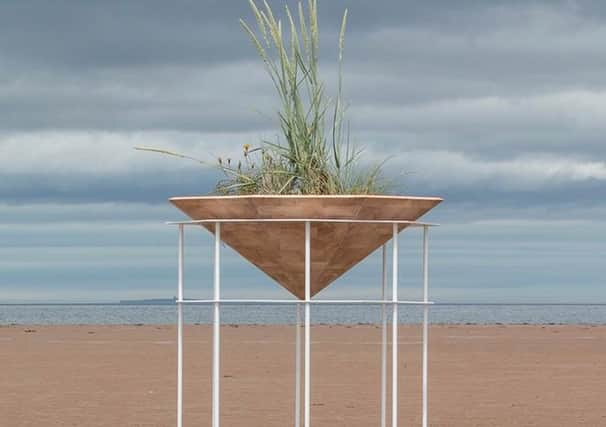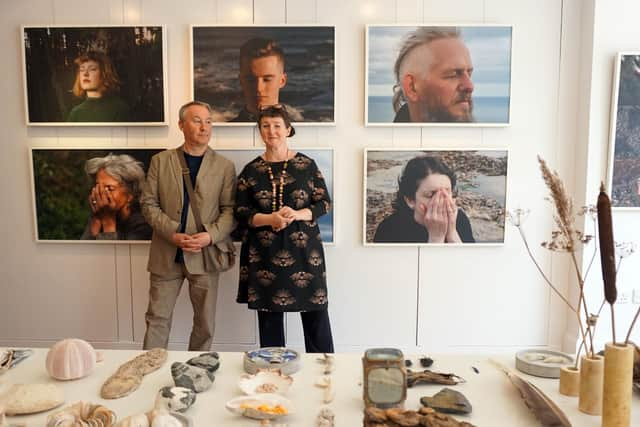North Light Arts marks ten years as a beacon of creativity


Meanwhile, back in our world, due to the ongoing corona-crisis the creative director of North Light, Susie Goodwin, has had to cancel the planned retrospective and is holding it online instead. Digital exhibitions, no matter how slick, can never be a substitute for seeing art in the flesh, but even though this show isn’t occupying a physical space it still provides a good opportunity to look back on what has been a remarkably successful decade.
Conceived as an organisation that would “develop a creative conversation between specialists and communities as a catalyst for a change in our relationship with the environment,” North Light’s first major project was called The Knitted Harbour, and, on the surface at least, it did exactly what it said on the tin. In August 2010, knitters from all over the town came together to create an impressively detailed replica of Dunbar Harbour, using wool from local hill farmers for which there was no market at the time, and this was then exhibited at various venues around Dunbar and East Lothian, as part of a programme of events that also included performances by local writers, folk musicians and the community choir.
Advertisement
Hide AdYou only need to look at the pictures of the knitted harbour taking shape, though, with teams of local artists working together at trestle tables down by the water’s edge, to realise that a lot more was being knitted together here than a few replica fishing boats. As Goodwin puts it, the project “inspired and connected people to their environment in an extraordinary way... and it brought both artists and the community together to think about our resources and how we use the places we share.”


After this auspicious start, Northern Light Arts has continued to grow and evolve and – thanks to its John Muir Residency scheme, named after the Dunbar native, pioneering environmentalist and father of America’s National Parks – it has been able to follow through on its stated aim of developing creative conversations between specialists and communities by inviting a number of leading artists to come and make work in the area.
In 2017, for example, Hannah Imlach created a spectacular new sculpture at Belhaven Bay, inspired by the coastal flora of East Lothian, called Dune Cradle, which saw a small clump of local plantlife placed on a stone plinth shaped like an inverted pyramid and raised safely above the tidal sands of Belhaven Bay on skinny, War of the Worlds-style stilts, like some futuristic harbinger of sea level rise. The same year, the poet and artist Alec Finlay used his residency to create a book, minnmouth, informed by the similarities he found between Norse-inflected local place names and other place names scattered all along the east coast, from Suffolk to Shetland.
In 2018, Dalziel + Scullion’s residency resulted in an exhibition entitled Homing, in which the duo assembled a myriad of objects they had found while exploring the local area, from shells and sea-urchins to feathers and fossils, and used this exquisitely-presented collection as an invitation to others to pay more attention to the treasures at their feet. Then, in 2019, Jenny Pope used her wonderfully eccentric “Tools to Evoke Change,” constructed from an array of bric-a-brac, and her solar-powered kinetic sculptures, to imagine a better, greener future. And all the while, the community art projects have kept on coming – the latest, Rebellious Threads, is a two-year initiative with Dunbar schools designed to get students thinking about swapping, re-designing and re-purposing old clothes, rather than simply throwing them away.
Much like North Light Arts itself, the 10th anniversary exhibition will evolve and grow over the coming months. Its title, What If, is taken from the book by environmentalist Rob Hopkins, From What Is To What If: Unleashing the Power of Imagination to Create the Future We Want. It’s a concept John Muir would surely have understood, and one of which he would have approved.


A message from the Editor:
Thank you for reading this story on our website. While I have your attention, I also have an important request to make of you.
Advertisement
Hide AdWith the coronavirus lockdown having a major impact on many of our advertisers - and consequently the revenue we receive - we are more reliant than ever on you taking out a digital subscription.
Subscribe to scotsman.com and enjoy unlimited access to Scottish news and information online and on our app. With a digital subscription, you can read more than 5 articles, see fewer ads, enjoy faster load times, and get access to exclusive newsletters and content. Visit https://www.scotsman.com/subscriptions now to sign up.
Joy Yates, Editorial Director